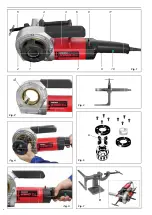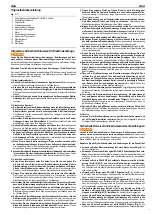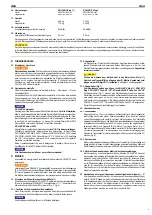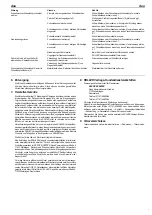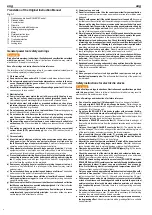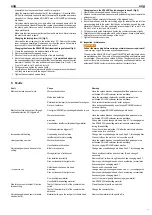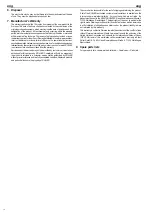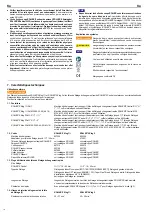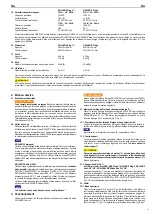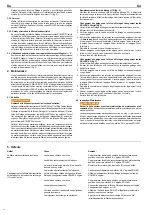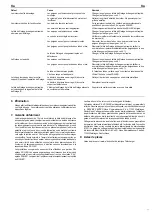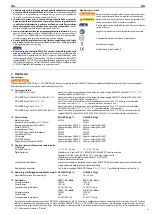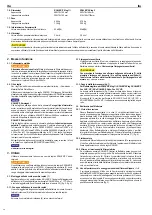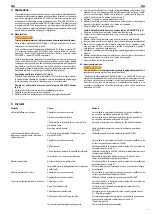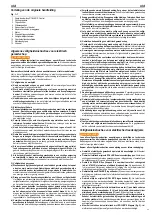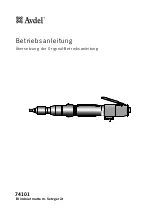
8
eng eng
Translation of the Original Instruction Manual
Fig. 1 – 7
1 Quick-change die head ROLLER’S Central
2 Die head holder
2
3 Counter holder
4 Prism die
5 Clamping spindle with feed screw
6 Pressing and carrying handle
7 Motor
8 Rotation direction lever
9 Safety inching switch
10 Overload protection
11 Motor handle
12 Locking lever
General power tool safety warnings
WARNING
WARNING
Read all safety warnings, instructions, illustrations and specifi cations provided
with this power tool. Failure to follow all instructions listed below may result in
electric shock, fi re and/or serious injury.
Save all warnings and instructions for future reference.
The term “power tool” in the warnings refers to your mains-operated (corded) power
tool or battery-operated (cordless) power tool.
1) Work area safety
a) Keep work area clean and well lit. Cluttered or dark areas invite accidents.
b) Do not operate power tools in explosive atmospheres, such as in the pres-
ence of fl ammable liquids, gases or dust. Power tools create sparks which
may ignite the dust or fumes.
c) Keep children and bystanders away while operating a power tool. Distractions
can cause you to lose control.
2) Electrical safety
a) Power tool plugs must match the outlet. Never modify the plug in any
way. Do not use any adapter plugs with earthed (grounded) power tools.
Unmodifi ed plugs and matching outlets will reduce risk of electric shock.
b) Avoid body contact with earthed or grounded surfaces, such as pipes,
radiators, ranges and refrigerators. There is an increased risk of electric shock
if your body is earthed or grounded.
c) Do not expose power tools to rain or wet conditions. Water entering a power
tool will increase the risk of electric shock.
d) Do not abuse the cord. Never use the cord for carrying, pulling or unplug-
ging the power tool. Keep cord away from heat, oil, sharp edges or moving
parts. Damaged or entangled cords increase the risk of electric shock.
e) When operating a power tool outdoors, use an extension cord suitable for
outdoor use. Use of a cord suitable for outdoor use reduces the risk of electric
shock.
f) If operating a power tool in a damp location is unavoidable, use a residual
current device (RCD) protected supply. Use of an RCD reduces the risk of
electric shock.
3) Personal safety
a) Stay alert, watch what you are doing and use common sense when oper-
ating a power tool. Do not use a power tool while you are tired or under
the infl uence of drugs, alcohol or medication. A moment of inattention while
operating power tools may result in serious personal injury.
b) Use personal protective equipment. Always wear eye protection. Protective
equipment such as a dust mask, non-skid safety shoes, hard hat or hearing
protection used for appropriate conditions will reduce personal injuries.
c) Prevent unintentional starting. Ensure the switch is in the off-position before
connecting to power source and/or battery pack, picking up or carrying the
tool. Carrying power tools with your fi nger on the switch or energising power
tools that have the switch on invites accidents.
d) Remove any adjusting key or wrench before turning the power tool on. A
wrench or a key left attached to a rotating part of the power tool may result in
personal injury.
e) Do not overreach. Keep proper footing and balance at all times. This enables
better control of the power tool in unexpected situations.
f) Dress properly. Do not wear loose clothing or jewellery. Keep your hair and
clothing away from moving parts. Loose clothes, jewellery or long hair can be
caught in moving parts.
g) If devices are provided for the connection of dust extraction and collection
facilities, ensure these are connected and properly used. Use of dust collection
can reduce dust-related hazards.
h) Do not let familiarity gained from frequent use of tools allow you to become
complacent and ignore tool safety principles. A careless action can cause
severe injury within a fraction of a second.
4) Power tool use and care
a) Do not force the power tool. Use the correct power tool for your application.
The correct power tool will do the job better and safer at the rate for which it was
designed.
b) Do not use the power tool if the switch does not turn it on and off. Any power
tool that cannot be controlled with the switch is dangerous and must be repaired.
c) Disconnect the plug from the power source and/or remove the battery pack,
if detachable, from the power tool before making any adjustments, changing
accessories, or storing power tools. Such preventive safety measures reduce
the risk of starting the power tool accidentally.
d) Store idle power tools out of the reach of children and do not allow persons
unfamiliar with the power tool or these instructions to operate the power
tool. Power tools are dangerous in the hands of untrained users.
e) Maintain power tools and accessories. Check for misalignment or binding
of moving parts, breakage of parts and any other condition that may affect
the power tool’s operation. If damaged, have the power tool repaired before
use. Many accidents are caused by poorly maintained power tools.
f) Keep cutting tools sharp and clean. Properly maintained cutting tools with
sharp cutting edges are less likely to bind and are easier to control.
g) Use the power tool, accessories and tool bits etc. in accordance with these
instructions, taking into account the working conditions and the work to be
performed. Use of the power tool for operations different from those intended
could result in a hazardous situation.
h) Keep handles and grasping surfaces dry, clean and free from oil and grease.
Slippery handles and grasping surfaces do not allow for safe handling and control
of the tool in unexpected situations.
5) Service
a) Have your power tool serviced by a qualifi ed repair person using only
identical replacement parts. This will ensure that the safety of the power tool
is maintained.
Safety instructions for electric die stocks
WARNING
WARNING
Read all safety warnings, instructions, illustrations and specifi cations provided
with this power tool. Failure to follow all instructions listed below may result in
electric shock, fi re and/or serious injury.
Save all warnings and instructions for future reference.
●
Do not use the power tool if it is damaged. There is a danger of accident.
●
Use only original ROLLER’S quick-change die heads. Quick-change die
heads from other manufacturers do not guarantee a secure fi t or damage the die
head holder (2) of the drive unit.
●
Do not use the ROLLER’S S die heads together with extension (Art.-No.
476035) with an electric die stock for cutting threads. The counter holder (3)
does not fi t. Otherwise there is a danger of the electric die stock being torn from
the hand and spinning round as the torque increases.
●
Always use a ROLLER’S counter holder (3). Otherwise there is a danger of
the electric die stock being torn from the hand and spinning round as the torque
increases.
●
Only use the original ROLLER’S counter holder (3). The electric die stock
could be damaged. There is also a danger of the electric die stock being torn out
of the counter holder and spinning round as the torque increases.
●
Do not reach into the area of the motor (7), pressing and carrying handle
(6) and counter holder (3) during operation. Only hold the electric die stock
by the motor handle (11). There is a risk of injury.
● Never let the power tool operate unattended. Switch off the power tool and
pull out the mains plug during longer work breaks. Electrical devices can
cause hazards which lead to material damage or injury when left unattended.
●
Clamp short pipe sections only with ROLLER’S Nipparo (Fig. 3). The electric
die stock and/or tools can be damaged.
●
Check the power cable of the electric die stock and extension leads regu-
larly for damage. Have these renewed by qualifi ed experts or an authorised
ROLLER customer service workshop in case of damage.
●
ROLLER’S thread-cutting material in aerosol cans (ROLLER’S Smaragdol,
ROLLER’S Rubinol 2000) contains environmentally friendly but infl ammable
propellant gas (butane). Aerosol cans are pressurised; do not open by
force. Protect them against direct sunlight and temperatures above 50°C.
The aerosol cans can burst. Danger of injury.
●
Only use approved and appropriately marked extension leads with a suffi -
cient cable cross-section. Use extension leads up to a length of 10 m with
cable cross-section 1.5 mm², from 10 – 30 m with cable cross-section 2.5 mm².
cable cross-section 1.5 mm², from 10 – 30 m w
cable cross-section 1.5 mm², from 10 – 30 m w
●
Children and persons who, due to their physical, sensory or mental abilities
or lack of experience and knowledge are unable to operate the power tool
safely may not use this electric die stock without supervision or instruction
by a responsible person. Otherwise there is a risk of operating errors and
injuries.
●
Only allow trained persons to use the power tool. Apprentices may only use
the power tool when they are over 16, when this is necessary for their training
and when they are supervised by a trained operative.
●
Avoid intensive skin contact with the thread-cutting materials because of
the degreasing effect. Use skin protectors with a greasing effect or a suitable
hand protection.


